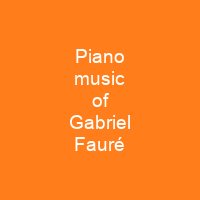Gabriel Fauré’s major sets of piano works are thirteen nocturnes, thirteen barcarolles, six impromptus, and four valses-caprices. For piano duet, he composed the Dolly Suite and, together with his friend and former pupil André Messager, an exuberant parody of Wagner in the short suite Souvenirs de Bayreuth. The composer disliked showy display, and the predominant characteristic of his piano music is a classical restraint and understatement.
About Piano music of Gabriel Fauré in brief

The authors of The Record Guide wrote that Fauree learnt restraint and beauty of surface from Mozart, tonal freedom and long melodic lines from Chopin and from Schumann. By using unresolved colour as well as mild discords and effects, Faurés anticipated the techniques of Impressionistist composers. In later years he anticipated the music was anticipated by Impressionists, and wrote music that was milder and more subdued. He never underestimated the challenges in composing for the instrument; he wrote, “In piano music there’s no room for padding – one has to pay cash and make it consistently interesting.” The composer was said to possess ‘that mysterious gift that no other can replace or surpass: charm\”, and charm is a conspicuous feature of many of his early compositions. His old friend Camille Saint-Saëns wrote to him in 1917, ‘Ah! if there is a god for the left hand, I should very much like to know him and make him an offering when I am disposed to play your music; the 2nd Valse-Caprice is terrible in this respect; I have however managed to get to the end of it by dint of absolute determination’. His other notable piano pieces, including shorter works, or collections composed or published as a set, are Romances sans paroles, Ballade in F♯ major, Mazurka in B♭ major, Thème et variations in C♯ minor, and Huit pièces brèves.
You want to know more about Piano music of Gabriel Fauré?
This page is based on the article Piano music of Gabriel Fauré published in Wikipedia (as of Nov. 21, 2020) and was automatically summarized using artificial intelligence.







